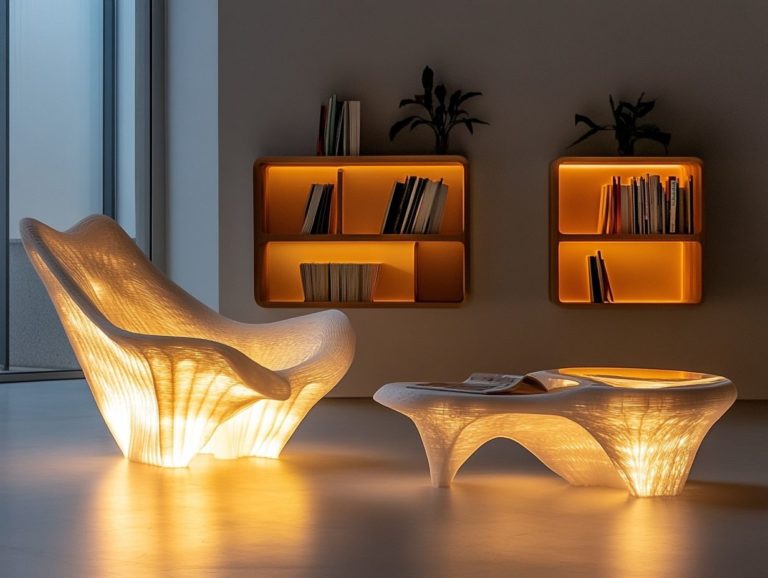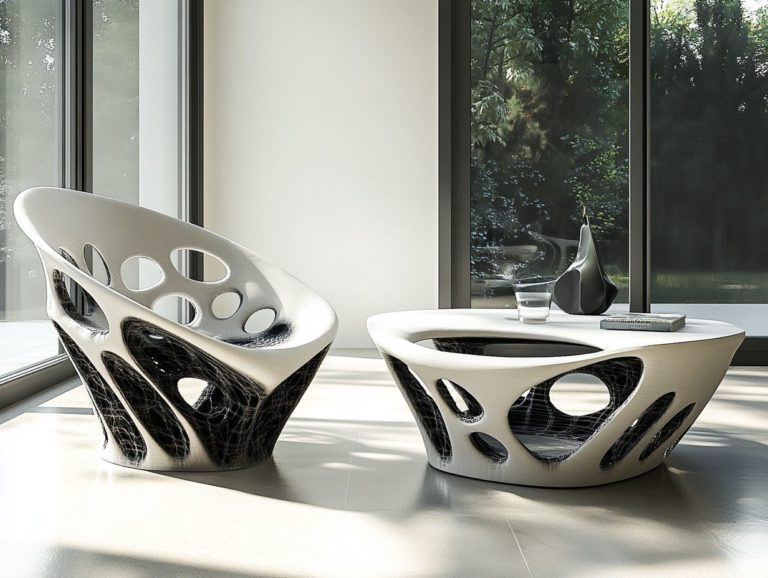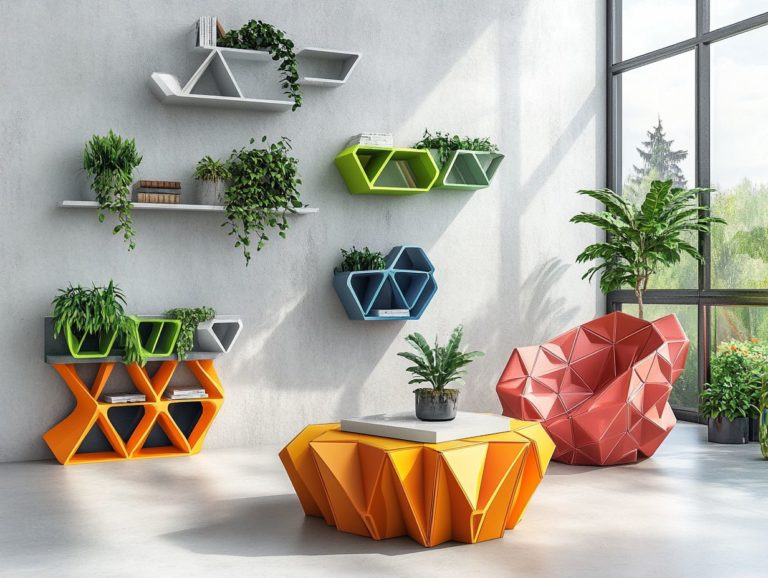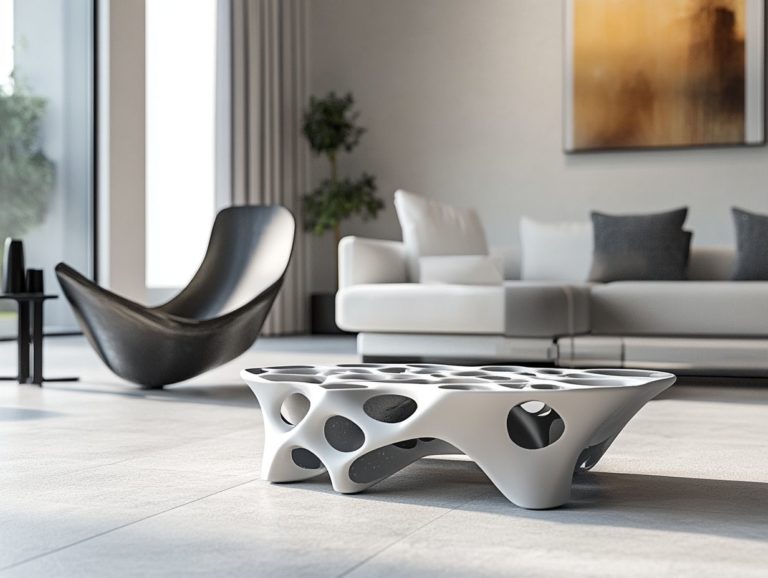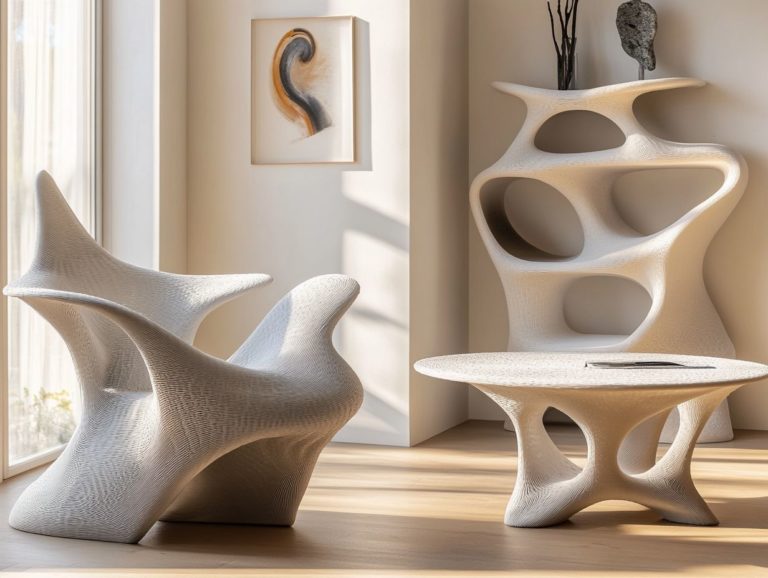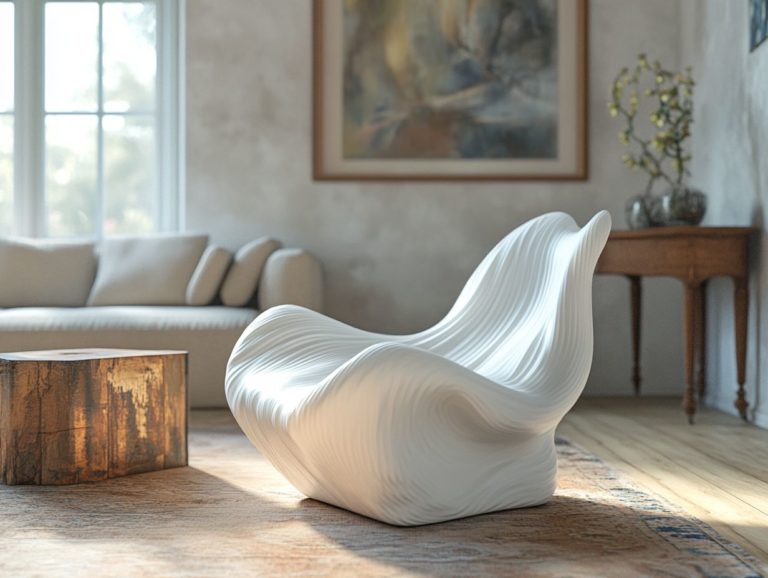3D-Printed Furniture: Trends to Watch in 2024
The world of home design is evolving rapidly, and 3D-printed furniture is leading the charge! This innovative approach not only offers exceptional customization but also champions sustainability, all while aligning with the latest trends in design and technology.
You can explore the numerous benefits of 3D-printed furniture, from the use of eco-friendly materials to its cutting-edge designs. We will also explore the anticipated market growth, potential challenges, and the future of this trend in 2024.
Contents
- Key Takeaways:
- Benefits of 3D-Printed Furniture
- Current Trends in 3D-Printed Furniture
- Predictions for 3D-Printed Furniture in 2024
- Frequently Asked Questions
- What is 3D-printed furniture?
- What are the benefits of 3D-printed furniture?
- What are some current trends in 3D-printed furniture?
- What are some potential drawbacks of 3D-printed furniture?
- How will 3D-printed furniture impact the furniture industry in 2024?
- Can 3D-printed furniture be used for commercial spaces?
Key Takeaways:
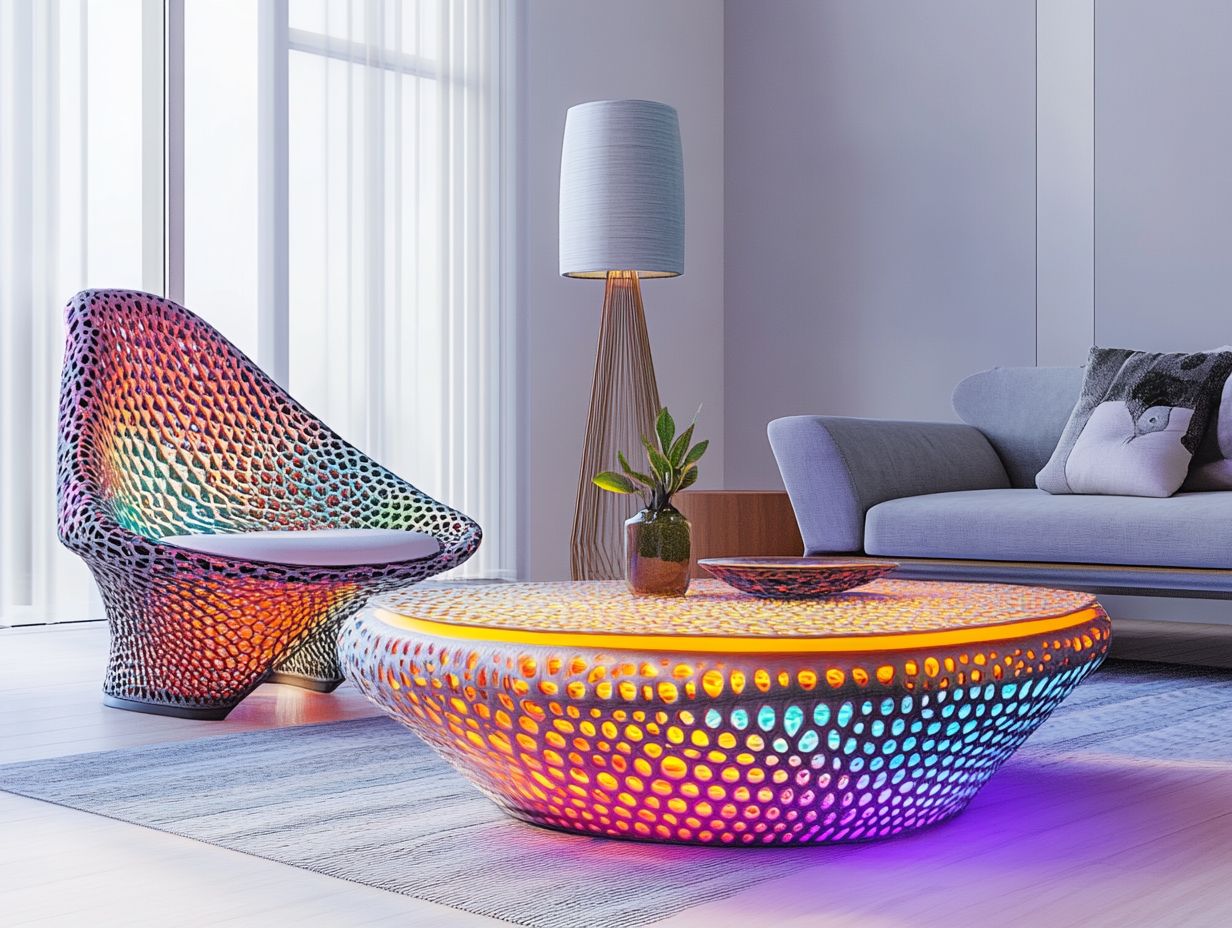
- Customization and sustainability will continue to be key benefits of 3D-printed furniture in 2024, as consumers seek unique and eco-friendly pieces for their homes.
- Expect to see even more innovative designs and materials in 3D-printed furniture, as manufacturers push the boundaries of what is possible with this technology.
- The integration of technology, such as embedded sensors and smart features, will revolutionize the functionality of 3D-printed furniture and enhance the overall user experience.
Explore the future of furniture with 3D printing.
What is 3D-Printed Furniture?
3D-printed furniture is transforming the landscape of the furniture industry, harnessing advanced manufacturing technologies to create designs that seamlessly blend functionality with aesthetic appeal. Unlike traditional furniture, which often clings to conventional manufacturing methods, 3D-printed options offer you the freedom to customize and explore geometric complexities that were once out of reach.
This innovative approach uses materials such as plastics, metals, and sustainable resources, crafting intricate models that cater to a wide array of consumer preferences and ergonomic needs.
Whether you’re opting for SLA (Stereolithography), a method that uses light to cure liquid resin into solid objects, or FDM (Fused Deposition Modeling), which uses melted plastic to build items layer by layer, each technology plays a vital role in expanding the horizons of creativity. With these printing processes, you can produce furniture in smaller batches, significantly reducing waste and minimizing environmental impact while aligning with sustainable practices.
3D-printed pieces often allow for easy modifications or repairs, which enhances their longevity and adaptability in a rapidly changing market. As you seek personalized solutions, the ability to tailor designs ensures that 3D-printed furniture stands out as a viable and forward-thinking alternative to traditional options.
Benefits of 3D-Printed Furniture
The advantages of 3D-printed furniture are numerous, offering you unparalleled customization and improved production efficiency. This innovative approach makes it an attractive option for both consumers and manufacturers.
By embracing advanced manufacturing techniques like additive manufacturing, companies can create furniture designs that not only minimize material waste but also align with sustainable practices. This way, you can enjoy furniture that meets modern consumer demands while contributing to a more environmentally friendly future.
Customization and Sustainability
Customization and sustainability are leading the charge in the 3D-printed furniture revolution, allowing you to create personalized pieces that reflect your unique tastes and lifestyle while championing eco-friendly practices. This innovative approach enables designers to explore a vast array of design options and levels of customization, all while using sustainable materials that minimize environmental impact and align with your values focused on sustainability.
For example, companies like PLYT offer platforms where you can choose dimensions, colors, and textures, crafting products that fit effortlessly into your home. By utilizing biodegradable plastics and recycled materials, they not only reduce waste but also cater to the growing demand for environmentally-conscious choices.
As you prioritize eco-friendly shopping, these practices become essential in building brand loyalty. You re not just looking for furniture; you re seeking ways to express your individuality while supporting sustainable design. This balance is pivotal in shaping the future of furniture manufacturing.
Ready to revolutionize your home? Explore your options in 3D-printed furniture today!
Current Trends in 3D-Printed Furniture
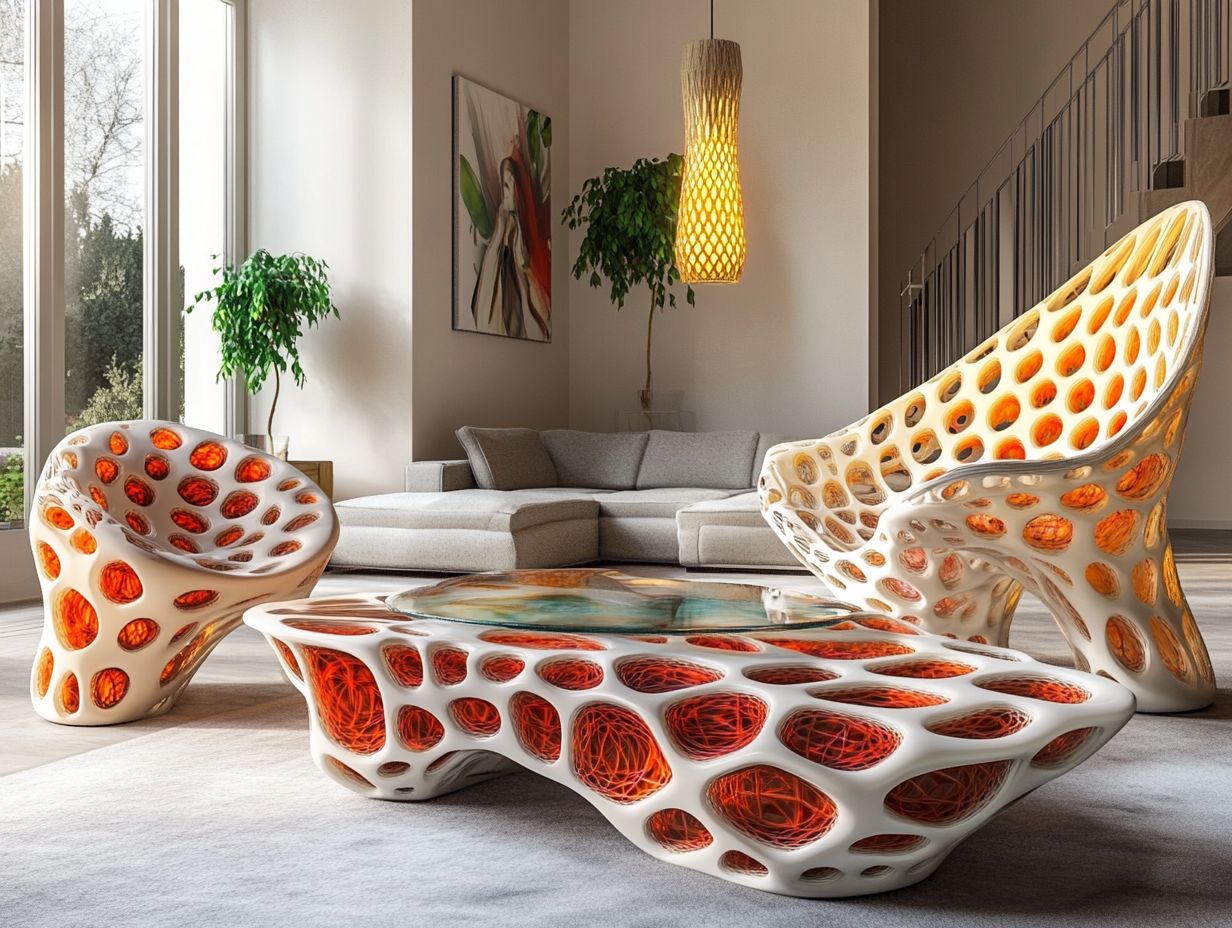
Current trends in 3D-printed furniture present a remarkable fusion of innovative materials and advanced printing techniques, redefining the future of furniture aesthetics and design. As the furniture industry undergoes transformation, you’ll notice a significant shift toward embracing cutting-edge technologies like SLA (Stereolithography) and SLS (Selective Laser Sintering), as highlighted in how 3D printing is revolutionizing furniture design.
These methods enable the creation of sophisticated furniture models that not only captivate consumer interest but also embody contemporary design philosophies.
Exciting Designs and Materials
Innovative designs and materials are transforming the realm of 3D-printed furniture, bringing forth unique creations inspired by nature through biomimicry. These designs cater to various ergonomic needs.
The incorporation of diverse materials, such as bioplastics and composites, grants you exceptional design flexibility. The ability to achieve intricate detailing enhances the overall aesthetics of each furniture piece.
These advancements enhance both looks and functionality, addressing the diverse demands of contemporary living spaces. For example, bioplastics derived from renewable resources offer an eco-friendly choice without compromising on durability. Meanwhile, composites can be customized for specific structural requirements.
As designers increasingly embrace ergonomic principles, they integrate rounded edges, adjustable components, and supportive structures that prioritize your comfort and well-being. This comprehensive approach ensures that each piece is not just a decorative element but a functional asset that seamlessly aligns with your lifestyle.
Integration with Technology
The integration of technology into 3D-printed furniture has transformed your approach to design. You can leverage digital models and state-of-the-art visualization tools to elevate the entire process.
This shift is clearly reflected in your newfound ability to produce intricate designs with remarkable precision and accuracy. It significantly streamlines production timelines.
Advanced visualization tools offer you a realistic preview of how a specific piece of furniture will look in your space, considering essential elements like light and shadow.
By enabling you to engage directly with the design process, these innovations create a sense of ownership and satisfaction. As you explore various configurations, the interactions become seamless and enjoyable, transforming furniture shopping into an engaging experience tailored to your unique needs and preferences.
Predictions for 3D-Printed Furniture in 2024
Predictions for 3D-printed furniture in 2024 suggest that you’ll witness remarkable growth in the industry. This surge is fueled by shifting consumer behavior and an increasing demand for cost-effective solutions that maintain quality and aesthetics, which you can learn more about in the future of 3D-printed furniture.
As manufacturers respond to market trends and your preferences, the influence of 3D printing technology is set to transform furniture production and the shopping experience. This evolution will lead to more accessible and personalized options tailored just for you.
Expected Growth and Market Impact
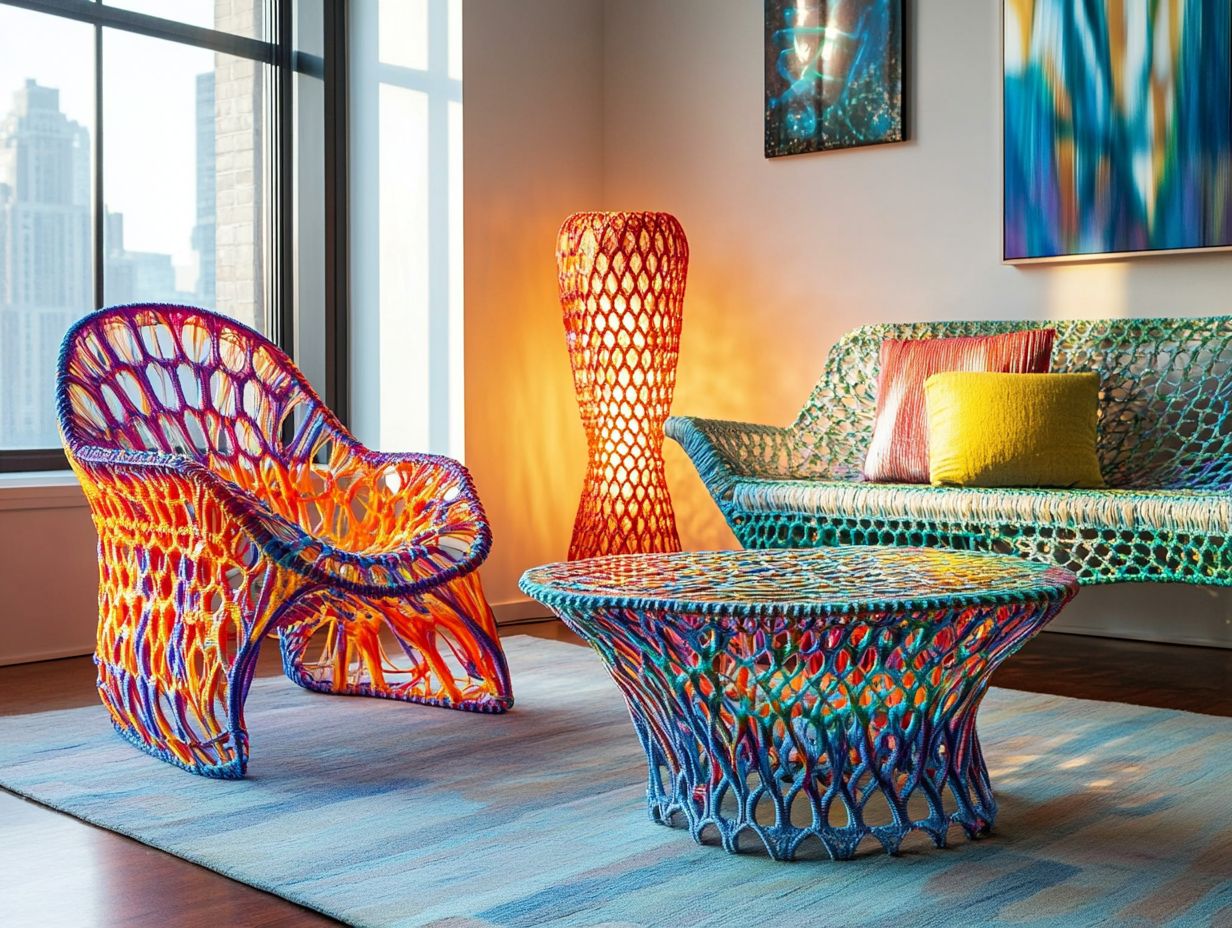
The anticipated growth and market impact of 3D-printed furniture look incredibly promising. It’s fueled by your increasing desire for personalized and sustainable options, as detailed in exploring the world of 3D-printed furniture design, that traditional manufacturing often struggles to deliver.
This potential for growth could usher in a significant transformation in furniture production processes, bringing them more in line with your preferences and reshaping the industry’s landscape.
Forecasts indicate that the 3D-printed furniture market might experience a compound annual growth rate (CAGR) exceeding 25% over the next five years. This signals a swift transition to sustainable living solutions through innovative designs.
As you become more environmentally conscious, the demand for sustainable materials like biodegradable filaments is expected to surge. This motivates manufacturers to adopt eco-friendly practices.
The ease of customization allows you to engage in the design process, creating a unique bond between you and the product. Companies that recognize and adapt to these trends will likely find themselves well-positioned in this evolving market, ready to cater to your preferences and values.
Don’t miss out on the future of 3D-printed furniture! Stay informed and embrace the exciting trends by learning how to style your space with 3D-printed furniture that are shaping this innovative industry.
Challenges and Solutions in 3D-Printed Furniture
3D-printed furniture has a bright future. However, you need to tackle challenges like manufacturing limits and environmental concerns to succeed.
Embracing innovative materials and sustainable practices will help you meet consumer demands while reducing your ecological footprint.
Relying on traditional production methods can restrict the unique benefits of 3D printing. This may affect the complexity and durability of your designs.
There are also concerns about waste from the printing process and the use of non-biodegradable plastics. Advancements in bioplastics can offer sustainable alternatives.
Engaging in a recycling system could further enhance sustainability, allowing you to recycle materials and lessen the overall environmental impact of 3D-printed furniture.
Frequently Asked Questions
What is 3D-printed furniture?
3D-printed furniture is crafted using a 3D printer. This technology builds objects layer by layer from digital designs, resulting in unique pieces.
What are the benefits of 3D-printed furniture?
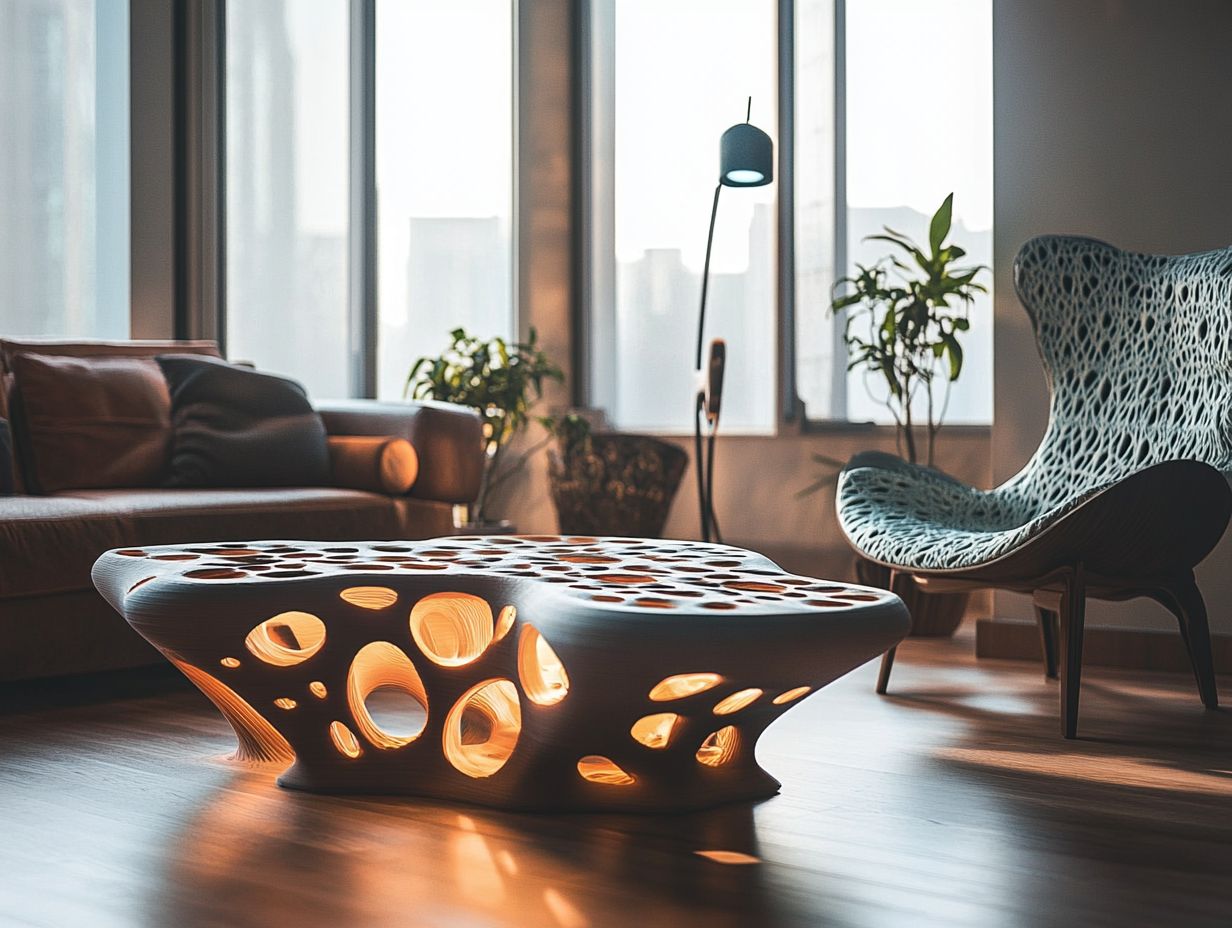
One major benefit of 3D-printed furniture is its customizability. These pieces can be designed to fit specific spaces and cater to individual preferences.
Additionally, 3D-printed furniture is often made from sustainable materials, making it an environmentally-friendly option.
What are some current trends in 3D-printed furniture?
Get ready for 2024, when biodegradable materials will transform 3D-printed furniture! Expect a rise in multi-functional and space-saving designs, along with innovative smart features as we explore the evolution of 3D-printed furniture.
What are some potential drawbacks of 3D-printed furniture?
One drawback of 3D-printed furniture is the time it takes to produce each piece. It can be a slow process, especially for larger items that may not suit those needing quick furniture solutions.
Another potential drawback is the cost, as 3D printing technology can still be quite expensive.
How will 3D-printed furniture impact the furniture industry in 2024?
In 2024, 3D-printed furniture is expected to significantly impact the furniture industry, showcasing trends in 3D-printed furniture that create more opportunities for customization and personalization, while providing sustainable options for consumers.
Can 3D-printed furniture be used for commercial spaces?
Yes, 3D-printed furniture can be used in commercial spaces. Many businesses are already incorporating these unique pieces into their designs to create a modern aesthetic.
In 2024, we can expect wider adoption of 3D-printed furniture in various commercial settings such as offices, hotels, and restaurants.

